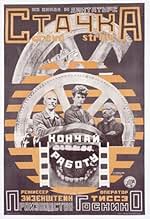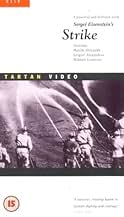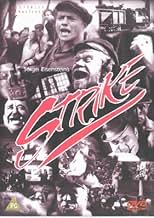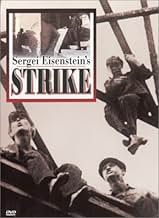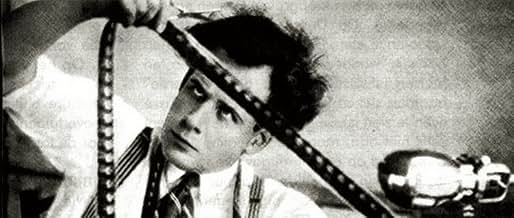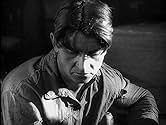CALIFICACIÓN DE IMDb
7.6/10
9.1 k
TU CALIFICACIÓN
Los trabajadores de una fábrica en la Rusia pre-revolucionaria, planean una huelga para exigir mejoras en la condición laboral después de que un hecho trágico impulse a terminar con su somet... Leer todoLos trabajadores de una fábrica en la Rusia pre-revolucionaria, planean una huelga para exigir mejoras en la condición laboral después de que un hecho trágico impulse a terminar con su sometimiento.Los trabajadores de una fábrica en la Rusia pre-revolucionaria, planean una huelga para exigir mejoras en la condición laboral después de que un hecho trágico impulse a terminar con su sometimiento.
- Dirección
- Guionistas
- Elenco
Leonid Alekseev
- Factory Sleuth
- (sin créditos)
Daniil Antonovich
- Worker
- (sin créditos)
Pyotr Malek
- Police Spy
- (sin créditos)
Misha Mamin
- Baby Boy
- (sin créditos)
Pavel Poltoratskiy
- Stockholder
- (sin créditos)
Opiniones destacadas
It takes place during the 1912 Factory Strike in Russia. This was the brilliant debut of Sergei Eisenstein which introduced the idea of montage. Done before Potemkin, Stachka/Strike(1925) is a film about the struggle of the working class against the Tsar. The film showed of things to come for the career of Eisenstein. This was to be part of a series of films concerning the events that led to the 1917 Revolution. He shows the working class as the main protagonist in Strike. Was co-written by frequent co-writer Grigori Aleksandrov.
Stachka and Battleship Potemkin would be the only films in which Eisenstein would have complete artistic control. Like Potemkin, it also features a grand massacre sequence. Eisenstein's direction is nothing short of first class. October(1927) can be looked upon as a sequel to Strike. The images of this is an example of why the silent period was the last truly great era of visual filmmaking. Strike would be the first of many great movies from a master artist. A fine scene is the superimposition of a slaughtered bull over a scene of massacred workers.
Stachka and Battleship Potemkin would be the only films in which Eisenstein would have complete artistic control. Like Potemkin, it also features a grand massacre sequence. Eisenstein's direction is nothing short of first class. October(1927) can be looked upon as a sequel to Strike. The images of this is an example of why the silent period was the last truly great era of visual filmmaking. Strike would be the first of many great movies from a master artist. A fine scene is the superimposition of a slaughtered bull over a scene of massacred workers.
Not Eisensteins most famous film, but it was his first and it's important in the history of cinema. The montage is brilliant and the inventive camerawork alone make it endlessly important. A routine story about workers striking put against the satire of the aristocracy, it seems most of the Russian silent films were like this, but the story isn't whats important in these films, it's the camera use. Eisenstein, Pudovkin, Kuleshov, these filmmakers are possibly the most important group of directors ever.
This is an impressive looking piece of Communists propaganda, that glorify the common worker, from Russian movie-making pioneer Sergei M. Eisenstein.
It's one of Eisenstein's first movies, which also means that he was experimenting a lot in the movie, with many different compositions and with fantastic fast editing that give the movie pace and make the sequences more exciting. Some of the sequences are highly creative and artistic looking, with great cinematography and camera-angels. It makes "Stachka" real eye-candy to watch. It's a real innovative movie and by watching it you realize that there was a real craftsman at work. It's an absolutely brilliantly directed movie!
Of course if you're looking for a movie with a good story and compelling characters, look further. The movie itself is pretty simple with its story and uses deliciously stereotypical characters, such as the capitalistic, fat, cigar smoking and drinking factory owners. The movie uses so many stereotypes that the movie intentionally also works out as an humorous movie. It's very welcome, since the movie in general in its story is very serious and tries to send out a message.
The story is perhaps easier to follow than in most other Eisenstein movies. It's a very simple story that on paper sounds to weak and uninteresting to fill a 90+ movie with. Yet the movie never bores and always remains interesting and 'enjoyable' to follow, also not in the least thanks to the rapid editing that makes sure none of the sequences go on for too long and allow the sequences to speak for itself, rather then relying on the actors their performances or title-cards.
An essential viewing for movie-lovers!
9/10
http://bobafett1138.blogspot.com/
It's one of Eisenstein's first movies, which also means that he was experimenting a lot in the movie, with many different compositions and with fantastic fast editing that give the movie pace and make the sequences more exciting. Some of the sequences are highly creative and artistic looking, with great cinematography and camera-angels. It makes "Stachka" real eye-candy to watch. It's a real innovative movie and by watching it you realize that there was a real craftsman at work. It's an absolutely brilliantly directed movie!
Of course if you're looking for a movie with a good story and compelling characters, look further. The movie itself is pretty simple with its story and uses deliciously stereotypical characters, such as the capitalistic, fat, cigar smoking and drinking factory owners. The movie uses so many stereotypes that the movie intentionally also works out as an humorous movie. It's very welcome, since the movie in general in its story is very serious and tries to send out a message.
The story is perhaps easier to follow than in most other Eisenstein movies. It's a very simple story that on paper sounds to weak and uninteresting to fill a 90+ movie with. Yet the movie never bores and always remains interesting and 'enjoyable' to follow, also not in the least thanks to the rapid editing that makes sure none of the sequences go on for too long and allow the sequences to speak for itself, rather then relying on the actors their performances or title-cards.
An essential viewing for movie-lovers!
9/10
http://bobafett1138.blogspot.com/
This is Eisenstein's directorial debut and alongside Citizen Kane it may be one of the most important debuts in the history of film showcasing a fully-fledged artistic maturity. This is a fictitious narrative-driven movie though it is very consonant with reality. As a Communist Eisenstein's aesthetics was opposed to the "bourgeois" art style that considered the artistic object as a subject of contemplation. Eisenstein advocated in theoretical terms in his books and practically with movies such as this a pragmatic vision of art. Movies should have a purpose; they should mobilize the viewer into action by filing him with emotion.
This strategy is obvious early on with the use of the motto from Lenin that links the idea of organized workers and that of social action in an equation of efficiency. The movie tries to prove that the workers are entitled to organization and that only in such a manner they could achieve their full potential. The movie focuses on the workers as a group; there are no "characters" as we have grown accustomed to seeing on screen. The collective character of the workers, though, has a very powerful emotional impact on the viewer because Eisenstein knows how to present it:
1) The workers are presented in the factory, in what would appear to Chaplin, for instance as a medium of alienation. Here, the workers seem "at home" because they are so many they balance the non-human elements expressed by the machines. More than this the brilliant montage sequences emphasize that the workers are in peace in their environment, the visual patters give a clear feeling of the strength of the united workers. Later on with the advent of sound the beauty of an industrial landscape will be extraordinarily depicted by Vertov in Enthusiasm;
2) The workers are contrasted with the fat and greedy capitalists. Their environment is luxurious and far more "human" than a factory. However, Eisenstein makes it appear as a place of sin and debauchery. The cigar smoke emphasizes the strength of the exploiter much like the smoke from the furnace shows the force of the factory. There are many correspondences between the two environments which Eisenstein later uses to achieve some of the greatest and most emotionally engaging associative montages ever displayed. One of the most impressive shows a boss squeezing a lemon to fix himself a drink while the workers are squished by the police forces trying to repress the strike;
3) Individuals predominantly appear only when they are associated with heavy dramatic scenes, the innocent worker who commits suicide ( who only functions as the dramatic instigator of the plot without any real emotion displayed for the actual character who dies even if we know his actual name; it is insinuated that a human life has a meaning only as part of larger community), the child who is killed by the police, the spies who serve as much needed humorous debouches that relieve the tension associated with the workers exploitation but that also build up tension in the sense that they show the stupidity of the bosses and of their methods;
4) The key to the movie is its pragmatics. It is after all a propaganda piece and the ending clearly shows it. The advice addressed to the proletarians not to forget is charged with emotion because it discharges a tension that has been carefully build frame by frame at a rampant pace. Even if we disengage with his doctrine we should keep in mind that Eisenstein's genius can only be acknowledged in its cultural context and related to his conception of art's function in a society. We can screen out the propaganda but we must keep the emotion in order to understand this movie today at its full power.
This strategy is obvious early on with the use of the motto from Lenin that links the idea of organized workers and that of social action in an equation of efficiency. The movie tries to prove that the workers are entitled to organization and that only in such a manner they could achieve their full potential. The movie focuses on the workers as a group; there are no "characters" as we have grown accustomed to seeing on screen. The collective character of the workers, though, has a very powerful emotional impact on the viewer because Eisenstein knows how to present it:
1) The workers are presented in the factory, in what would appear to Chaplin, for instance as a medium of alienation. Here, the workers seem "at home" because they are so many they balance the non-human elements expressed by the machines. More than this the brilliant montage sequences emphasize that the workers are in peace in their environment, the visual patters give a clear feeling of the strength of the united workers. Later on with the advent of sound the beauty of an industrial landscape will be extraordinarily depicted by Vertov in Enthusiasm;
2) The workers are contrasted with the fat and greedy capitalists. Their environment is luxurious and far more "human" than a factory. However, Eisenstein makes it appear as a place of sin and debauchery. The cigar smoke emphasizes the strength of the exploiter much like the smoke from the furnace shows the force of the factory. There are many correspondences between the two environments which Eisenstein later uses to achieve some of the greatest and most emotionally engaging associative montages ever displayed. One of the most impressive shows a boss squeezing a lemon to fix himself a drink while the workers are squished by the police forces trying to repress the strike;
3) Individuals predominantly appear only when they are associated with heavy dramatic scenes, the innocent worker who commits suicide ( who only functions as the dramatic instigator of the plot without any real emotion displayed for the actual character who dies even if we know his actual name; it is insinuated that a human life has a meaning only as part of larger community), the child who is killed by the police, the spies who serve as much needed humorous debouches that relieve the tension associated with the workers exploitation but that also build up tension in the sense that they show the stupidity of the bosses and of their methods;
4) The key to the movie is its pragmatics. It is after all a propaganda piece and the ending clearly shows it. The advice addressed to the proletarians not to forget is charged with emotion because it discharges a tension that has been carefully build frame by frame at a rampant pace. Even if we disengage with his doctrine we should keep in mind that Eisenstein's genius can only be acknowledged in its cultural context and related to his conception of art's function in a society. We can screen out the propaganda but we must keep the emotion in order to understand this movie today at its full power.
Russian master Sergei Eisenstein's first feature film is a tour-de-force of cinematic technique. He appears to have a pretty speedy learning curve, beginning straight away with a picture that is confidently crafted and extremely watchable even today.
With the exception of Que Viva Mexico (which he made outside Russia), this is Eisenstein's purest film, the one most free from the constraints of the Bolshevik propaganda machine. There is one mention of the Bolsheviks, but it's inconsequential. This is essentially a film about self-organisation of the workers a placeless and timeless story which acts as a case study in how a strike can begin, how it can be made successful and how it can be defeated.
Strike has an incredibly exhilarating pace to it and, aside from its political message works as a pure action film. Perhaps unusually for a debut film, this is also the closest Eisenstein came to making a comedy. In a style that would mark all his films, he characterises the villains of the piece the factory management, police chiefs and government bureaucrats as exaggerated and often ridiculous figures of fun. The factory owner is the stereotypical capitalist a top hat-wearing fat controller.
As usual with early Soviet cinema, Strike is essentially characterless. The story is told through the masses, and the proletariat as a whole is the hero. Eisenstein was ideally suited to this, as even in this early film he gives an unprecedented realism to the crowd scenes, and uses every technique at his disposal to create drama from mass action. Eisenstein also demonstrates early on that he has the rather unusual talent of directing large groups of people being massacred. It's an image that would crop up in nearly all of his films.
The only real weakness of Strike is that it too often slips into pretentiousness. Some of the techniques are little more than showing off. There are just a few too many superimpositions and mirror images shots. The symbolism is also often a little too heavy-handed and abstract the two kids dancing on the table during the interrogation scene certainly baffles me; god knows what the Russian public made of it.
Eisenstein is often described as a pioneer, a founding father of film technique. However, in truth most of the techniques he used had been developed earlier, in particular by D.W. Griffith. It's just that Eisenstein pushed the possibilities of editing to their extreme. He's more of a maverick than a pioneer, as there really has been no-one like him since. Having said that, I can identify three new uses of the editing process that Eisenstein invented with Strike.
Firstly, he often uses a sequence of similar shots to give the impression of the same action being done by lots of people. For example, three shots of tools being thrown to the ground tells us quickly and effectively, in the context of the scene, that the entire workforce is downing tools. Secondly, he edits rhythmically to punctuate action. For example, a quick, dynamic action like someone throwing a punch or a door slamming shut will be punctuated by a film cut, giving it much more impact. This is particularly effective in silent film, as the jarring cuts mean you can almost hear the action in your head.
The third editing technique debuted here was the most abstract and the least influential. Whereas Griffith would edit back and forth between two or more literally related scenes (for example, between someone in trouble and someone coming to rescue them) to build up tension, Eisenstein edits back and forth between unrelated images to create a metaphor. The well-known example of this in Strike is the cutting from the workers being gunned down to shots of cattle being slaughtered the cattle dying is nothing to do with the plot, but it makes a point. It's a clever idea, but one that was rarely imitated as it breaks up the flow of a film's narrative.
On a totally different note, a little hobby of mine is spotting modern day look-alikes in old films, and Strike has one of my favourites. The king of the beggars is a dead ringer for Shane MacGowan, right down to the missing teeth. Amazing.
Strike has to be one of the most remarkable and mould-breaking debut films of all time. It's not quite up to the level of masterpiece yet, but it's an incredible experience and genuinely gripping entertainment.
With the exception of Que Viva Mexico (which he made outside Russia), this is Eisenstein's purest film, the one most free from the constraints of the Bolshevik propaganda machine. There is one mention of the Bolsheviks, but it's inconsequential. This is essentially a film about self-organisation of the workers a placeless and timeless story which acts as a case study in how a strike can begin, how it can be made successful and how it can be defeated.
Strike has an incredibly exhilarating pace to it and, aside from its political message works as a pure action film. Perhaps unusually for a debut film, this is also the closest Eisenstein came to making a comedy. In a style that would mark all his films, he characterises the villains of the piece the factory management, police chiefs and government bureaucrats as exaggerated and often ridiculous figures of fun. The factory owner is the stereotypical capitalist a top hat-wearing fat controller.
As usual with early Soviet cinema, Strike is essentially characterless. The story is told through the masses, and the proletariat as a whole is the hero. Eisenstein was ideally suited to this, as even in this early film he gives an unprecedented realism to the crowd scenes, and uses every technique at his disposal to create drama from mass action. Eisenstein also demonstrates early on that he has the rather unusual talent of directing large groups of people being massacred. It's an image that would crop up in nearly all of his films.
The only real weakness of Strike is that it too often slips into pretentiousness. Some of the techniques are little more than showing off. There are just a few too many superimpositions and mirror images shots. The symbolism is also often a little too heavy-handed and abstract the two kids dancing on the table during the interrogation scene certainly baffles me; god knows what the Russian public made of it.
Eisenstein is often described as a pioneer, a founding father of film technique. However, in truth most of the techniques he used had been developed earlier, in particular by D.W. Griffith. It's just that Eisenstein pushed the possibilities of editing to their extreme. He's more of a maverick than a pioneer, as there really has been no-one like him since. Having said that, I can identify three new uses of the editing process that Eisenstein invented with Strike.
Firstly, he often uses a sequence of similar shots to give the impression of the same action being done by lots of people. For example, three shots of tools being thrown to the ground tells us quickly and effectively, in the context of the scene, that the entire workforce is downing tools. Secondly, he edits rhythmically to punctuate action. For example, a quick, dynamic action like someone throwing a punch or a door slamming shut will be punctuated by a film cut, giving it much more impact. This is particularly effective in silent film, as the jarring cuts mean you can almost hear the action in your head.
The third editing technique debuted here was the most abstract and the least influential. Whereas Griffith would edit back and forth between two or more literally related scenes (for example, between someone in trouble and someone coming to rescue them) to build up tension, Eisenstein edits back and forth between unrelated images to create a metaphor. The well-known example of this in Strike is the cutting from the workers being gunned down to shots of cattle being slaughtered the cattle dying is nothing to do with the plot, but it makes a point. It's a clever idea, but one that was rarely imitated as it breaks up the flow of a film's narrative.
On a totally different note, a little hobby of mine is spotting modern day look-alikes in old films, and Strike has one of my favourites. The king of the beggars is a dead ringer for Shane MacGowan, right down to the missing teeth. Amazing.
Strike has to be one of the most remarkable and mould-breaking debut films of all time. It's not quite up to the level of masterpiece yet, but it's an incredible experience and genuinely gripping entertainment.
¿Sabías que…?
- TriviaStrike (Russian: La huelga (1925)) is a Soviet silent propaganda film edited and directed by Sergei Eisenstein. Originating as one entry out of a proposed seven-part series titled "Towards Dictatorship of the Proletariat," Strike was a joint collaboration between the Proletcult Theatre and the film studio Goskino. As Eisenstein's first full-length feature film, it marked his transition from theatre to cinema, and his next film El acorazado Potemkin (1925) (Russian: Bronenosets Potyomkin) emerged from the same film cycle.
- ErroresThe story is set in 1903. Throughout the film, automobiles from the 1920s appear on streets. One is the 1920s auto that the worker (who stole the administrators' posted reply to workers' demands) tried to use to escape police goons during a nighttime rainstorm. When upper-class women appear, they are wearing contemporary 1920s fashions, and the popular music that's on the sound track is also from the 1920s.
- Citas
Title Card: At the factory, all is calm. BUT. The boys are restless.
- Versiones alternativasThe film was restored at Gorky Film Studio in 1969.
- ConexionesEdited into Ten Days That Shook the World (1967)
Selecciones populares
Inicia sesión para calificar y agrega a la lista de videos para obtener recomendaciones personalizadas
- How long is Strike?Con tecnología de Alexa
Detalles
- Tiempo de ejecución1 hora 22 minutos
- Color
- Mezcla de sonido
- Relación de aspecto
- 1.33 : 1
Contribuir a esta página
Sugiere una edición o agrega el contenido que falta

Principales brechas de datos
What is the Canadian French language plot outline for La huelga (1925)?
Responda

